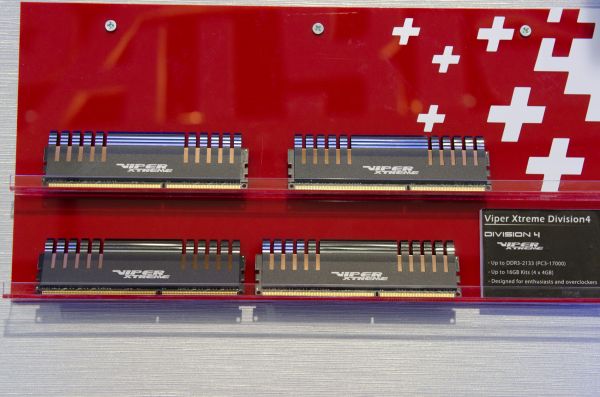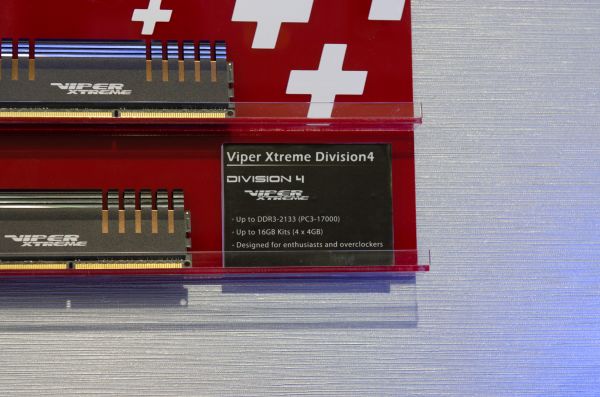Patriot: 16GB is the new 8GB for Sandy Bridge-E
by Anand Lal Shimpi on June 1, 2011 3:04 AM EST- Posted in
- Trade Shows
- Memory
- Sandy Bridge
- Patriot
- Computex 2011
Patriot gave me a preview of their new Viper Xtreme Division4 DDR3 memory due out later this year. Patriot is targeting this new line at Sandy Bridge E systems, which support up to four channels of DDR3 memory (official support for DDR3-1600, but overclocking will surely be an option).
Given the current price of memory, Patriot expects the default configuration for SNB-E systems to be a kit of four 4GB DIMMs for a total of 16GB. Sandy Bridge E isn't expected until the Fall at the earliest so memory pricing isn't certain, but Patriot expects a 16GB SNB-E memory kit to sell for around $130 when Division4 is released later this year.












50 Comments
View All Comments
AdamK47 - Wednesday, June 1, 2011 - link
Have you stopped playing PC games in 06?ciukacz - Wednesday, June 1, 2011 - link
no, i am currently playing witcher 2 which has rather high requirementssoftdrinkviking - Wednesday, June 1, 2011 - link
i think the implication was that most games are written at the level of the current generation of consoles and then spiced-up with after-effects for the PC versions.so when the next generation of consoles comes out, we can expect higher resource usage in the PC versions as well.
eamon - Wednesday, June 1, 2011 - link
I cross-compile some stuff using mingw; and there's a limitation in make on windows which means that you either fully parallelize all compilations or do it in serial. Since each compilation process can easily eat 100-400MB, this gets out of hand quite quickly, and when it does, you can kiss the machine goodbye: everything grinds to a halt. Pressing numlock takes minutes, and starting something like the task manager is hopeless even after several hours.A little more usual perhaps would be zipping: 7-zip eats tons of ram, and compresses better the more you have.
I'm thinking 4GB for an average user, however, is probably OK. I'd still recommend 8 since it's not that much more expensive and it's so terribly annoying when you run out, but 16 really sounds like overkill. For an average user - I can't wait to get more :-).
mathew7 - Wednesday, June 1, 2011 - link
I actually had such a problem under linux with 2GB RAM while compiling the kernel. I found out that a "fair-usage" IO scheduling algorithm (which I believe windows uses) can be the culprit. This was my router (which has power to do even more). During the compiling I noticed my web browsing just stopped (timeout for every connection). Then ssh-ing in to the router took more than 1 minute and I saw HDD led was lit (not just blinking).Under linux the CFQ scheduler would monitor process IO usage give priority to tasks which have low usage. But, the gcc executions of make would mean new priority processes. So it would prioritize the whole make process (thousands of gcc executions) and even the IP routing was brought down (because of swap space probably). It took me 30 mins to stop the build process.
In short: a "fair-usage" scheduling algorithm is killed by hundreds/thousands of short processes.
jonup - Wednesday, June 1, 2011 - link
While I agree with you the 4GB would be sufficient for the average user, most of the time, think of the abilities you have with 16+GB of RAM. You cannot utilize a ramdisk if you only have 2,4, or even 6GB of excess ram. But if you have a system with 16GB you can probably run your OS on a 10-12GB ramdisk. Or even better on a 32GB you can run your OS and a few most oftenly used apps on a 24-26GB ramdisk and the rest of your apps off an SSD. With Ramdisk you get several fold the performance of the OCZ Z-drive performance. With SNB-E quad-channel controller you might be hitting 10+GB/s.neotiger - Wednesday, June 1, 2011 - link
Ummm, the "average home user" doesn't need Sandy Bridge, period. He also doesn't play computer games other than maybe Farmville or Cityville. He *definitely* doesn't need a discreet GPU.My guess is that very soon the average home user will mostly be using $199 tablets with ARM or Atom cpu and 2G RAM.
But then again, anandtech has never been geared towards the average home users.
NordicRuneProject - Wednesday, June 1, 2011 - link
You've no idea of what you're talking about, right?A "normal" 32-bit application under a 32-bit OS can already allocate up to 2 GB's of RAM. 64 bit apps (under a 64-bit OS) can allocate tons more. And if you think modern games "rarely use over 1 gb" is that your concept of a "modern game" involves Pac-Man.
ciukacz - Thursday, June 2, 2011 - link
yes, i am perfectly aware of those limits.maybe you were playing pacman 4d on a ps2 emulator and you just didn't notice ?
albatrozz - Sunday, June 5, 2011 - link
Since most consumers don't upgrade every 6 months as many of us might, consumers shouldn't buy computers for what they need today, but for what they'll need down the road. A PC with 16GB is overkill for most users today, but it won't be forever. And in fact, buying PCs with anemic amounts of RAM is one of the biggest problems with consumers today -- they'll spend $500 for a five year old C2D with 2GB of RAM and end up needing a new PC in a year (well, actually, right away in most cases, but they don't notice immediately because their shiny new PC is SO much faster than their old Athlon was).In any event, any power user can easily exceed 8GB of RAM usage, especially (as mentioned elsewhere) people running VMs, but even those doing significant multitasking. And at a mere $130 for 16GB, it's not exactly a huge waste of money if they don't need all that RAM either. Bigger isn't *always* better, but when price is roughly equal, then yes, you might as well go with more capacity.